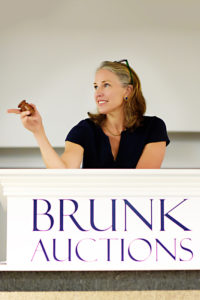Brunk Auctions and the William N. Banks, Jr. Estate
by Taryn Clary
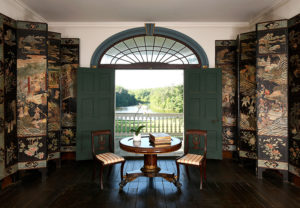
Interior view of Bankshaven, Newnan, GA. Featuring a Chinese Coromandel Lacquer Twelve Panel Screen (lot 9), Philadelphia Marble Top Center Table (lot 11), and Two Eagle and Lyre Carved Side Chairs (lot 123). Courtesy of Brunk Auctions, Asheville, NC, and The Magazine Antiques.
On September 12, Brunk Auctions will open its fall season with the spectacular single-owner sale of the Estate of William N. Banks, Jr. Bill Banks, who passed away at 95 years old in 2019, was a renowned collector, connoisseur, and frequent contributor to The Magazine Antiques. In the 1960s, he began collecting fine and decorative art, sculptures, prints, books, and more. The expansive breadth of his interests is reflected in the 327 lots on offer. Banks focused in particular on 19th-century American paintings and Neoclassical and Classical furniture, suited for display in his historic property Bankshaven in Newnan, GA. He acquired these works not only for their aesthetic value and fitness to the 1820s period home, but also for their histories. Each lot is accompanied by Banks’s exceptionally detailed records, demonstrating their provenance and his passion.
Brunk Auctions, founded in 1983 by Robert Brunk in Asheville, NC, is a perfect site for the sale of the southern scholar’s estate. The auction house is currently run by Brunk’s son Andrew and his wife Lauren, both alumni of the University of Delaware’s Winterthur Program in Early American Culture with a wealth of experience in Americana, furniture, and antiques. In advance of the highly anticipated auction, Lauren Brunk shared her thoughts on collecting, several standout objects, and the distinctive quality of the complete Banks collection.
Decorative Arts Trust: How has business at Brunk Auctions changed in response to the COVID-19 crisis?
Lauren Brunk: Our response continues to evolve, but the biggest shift has been on auction day. Staff are at home, armed with their list of phone bidders and logged into our website. The whole auction is orchestrated at the gallery by the auctioneers using various online platforms, Zoom, absentee bids, and phone bids. It’s pretty remarkable. Pickups can feel like Navy Seal operations: planned so the execution is precise, fast, and safe. We have a team that has risen to the challenge.
DAT: How have Brunk’s clients responded?
LB: Wow, our clients have responded like absolute champions. We were concerned at first that a digital environment might provide some barrier to entry especially to clients that are older, but at this point being older is no indication of the ability to use technology. So many of our clients are accustomed to doing things online that it has been a very smooth transition.
DAT: How would you gauge interest in decorative arts at this time?
LB: The market for quality decorative arts is still very strong. The Banks collection is a great example of this. When quality goes down, so does interest from the market.
DAT: As an experienced auctioneer, what are your thoughts on the shift to live-streamed auctions and online bidding? Has technology changed Brunk’s auction format for good?
LB: I don’t think technology or current social distancing mandates will change our format for good. It is so much more exciting to have our clients in the sale room, engaging in the process firsthand. Their temporary absence is the only change we have made. We have been using digital platforms alongside in-person auctions for over a decade, and it is a very effective combination.
DAT: How have you been able to accommodate the need for clients to see objects in person? Is the challenge of examining objects first hand impacting particular segments of the market?
LB: Ah the miracle of technology! High resolution images, video conferencing, and an extremely talented photography staff allow for a lot of information to come to you digitally. Before an auction you might find a number of specialists wandering the galleries doing a virtual walk-through with a client. In-person preview is still available by appointment.
DAT: What makes Brunk Auctions the ideal setting for the sale of the William N. Banks, Jr. Estate?
LB: We have an exceptionally knowledgeable staff, we have world-class catalogs, and we are enthusiastic beyond compare. A collection like this, one that was so lovingly assembled and is so broadly appreciated, is incredibly rewarding to handle. Because both Andrew and I have been in the field for some time, we have personal connections with collectors and curators that might go back 30 years in some cases. That is true for others on our team as well, many of whom have decades of experience in their fields. And, as a southern collection with close ties to New York, this one really is a perfect fit!
DAT: What is the advantage of selling a significant single-owner estate like this in its entirety, as opposed to dividing property into sales by time period, culture, or medium?
LB: When the entire collection is laid out in the catalog it can feel as if you are taking a private tour with Bill Banks. And let’s face it, everybody wanted to be invited to lunch at Bankshaven. This collection is characteristic of “the good old days” of collecting and very enjoyable to experience. It also allows for great cross pollination. You might come for a painting, but leave with a lamp and a book as well.
DAT: Mr. Banks kept impeccable records regarding his acquisitions. How important is that information to prospective buyers?
LB: Bill Banks’ recordkeeping is unparalleled. His files would rival any museum’s object folders, and that information will stay with each object when it is sold. Some files were over an inch thick. He purchased from top dealers back in the late 1960s and 1970s, a time when great things were still more widely available. It is no surprise that collectors love to know where things came from, and many of these objects have been published and researched many times over their life with Bill Banks, adding to the lustre and history.
DAT: Do you have a favorite piece in the sale?
LB: The New York Grecian Sofa (lot 39) is just so beautiful, and I have had a soft spot for the form since my days as a student at Winterthur. They just beg to be lounged on, and of course that was against the rules, which makes you want to do it all the more. We are not a museum so within reason, lounging on the furniture is perfectly acceptable—it is just market research.
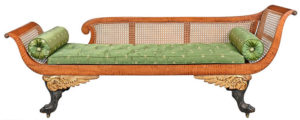
Fine and rare tiger maple gilt and vert Grecian sofa. New York, 1815-1820. 30 ¼ x 79 x 24 in. The Estate of William N. Banks, Jr., Newnan, Georgia. Estimate: $20,000 – $30,000.
DAT: What decorative arts objects have generated the most interest from prospective buyers?
LB: It is fun to watch regional buyers come to life—Boston calls for Boston objects, Philadelphia calls for Philadelphia objects. The Duncan Phyfe Caryatid table (lot 35) has caused a stir. It is so graphic, and the iconic form is well known and well documented. It also has a great history. Banks bought it from his cousin, Olive Pringle Brown of the Charleston Pringles, back in the late 1960s.
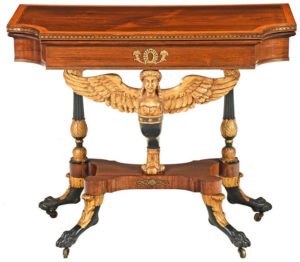
Attributed to Duncan Phyfe. Fine classical gilt, vert antique, and rosewood caryatid table, 1815-1820. 29 ¼ x 35 ¾ x 18 in. The Estate of William N. Banks, Jr., Newnan, Georgia. Estimate: $40,000 – $60,000.
DAT: Headlined by paintings by Asher B. Durand and Raphaelle Peale, the sale also includes a study by Eastman Johnson for his iconic Negro Life at the South. In the midst of the contemporary social justice movements striving for equality, is this powerful and complex image receiving special attention?
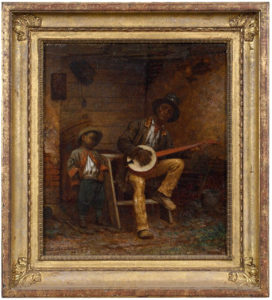
Eastman Johnson, Confidence and Admiration, 1859. Oil on canvas, 14 x 12 in. The Estate of William N. Banks, Jr., Newnan, Georgia. Estimate: $150,000 – $250,000.
LB: That is a great question, and difficult to answer with any brevity. We have made a very conscious effort to be sure that our colleagues at institutions as well as those working on Eastman Johnson’s catalog raisonné have had full access to the painting. The way in which institutions and private collectors are responding to the current social justice movement is the stuff of lectures, podcasts, online forums, and Zoom discussions. It would be hard to encapsulate here. However, the work itself represents just one of the many narratives conveyed in the larger Negro Life at the South. In this work, Confidence and Admiration, some see the humanity of the subjects in their emotions and struggles and others see imagery that provides a foothold for stereotypes. This complexity, and its ability to provide a starting point for conversation, is what makes it such an important painting. Dr. Patricia Hills has written extensively on Johnson’s work, and I recommend her research as part of the discovery process.
DAT: Do you and Andrew collect? Are your children interested in the auction business?
LB: I am not sure collect is the right word. Andrew has a wonderful eye for paintings, and those are pretty safe on the walls. We have always had an interest in Gothic Revival, and I am more of a magpie: If it is shiny or quirky it draws me in. Historically our answer to that question is, “yes, Lego,” but as our children have grown (16, 14, 11) it’s less true. It might be early to know if any of them will follow us into the art world, but I brought my bored 16 year old to work this summer and he helped me catalog paintings. He did a great job, so we will see.
If you would like to receive a copy of the William Banks catalog, please call 828.254.6846 or email info@brunkauctions.com. Be sure to tune into the auction live on September 12 at 9:00 am EDT, and in April 2021 join Brunk Auctions for research, community, and bourbon at the rescheduled Decorative Arts Trust Spring Symposium in Kentucky!
Update: Brunk Auctions’ post-sale press release reports that “In total, the single-owner 328-lot sale brought roughly $4.7 million, far exceeding its pre-auction estimates and widely reinforced that the market and appetite for 19th century American paintings and Federal and Classical American furniture is alive and well.” Andrew Brunk shares, “We are thrilled with the results of the William N. Banks, Jr. sale….One of the really exciting things about this sale was the breadth of response. Almost every major piece in the collection went to a different collector in a remarkable spread geographically all over the U.S., with buyers from Asia and the UK. A lot of collectors and dealers joined us in our excitement to feel the life and excitement back in this part of the market. Those kinds of numbers haven’t been realized in a long time, and it truly felt like a landmark sale within this focused part of the field. William N. Banks, Jr. was the quintessential collector and it really got the attention of those who appreciate that style and period.”
About The Decorative Arts Trust Bulletin
Formerly known as the "blog,” the Bulletin features new research and scholarship, travelogues, book reviews, and museum and gallery exhibitions. The Bulletin complements The Magazine of the Decorative Arts Trust, our biannual members publication.








